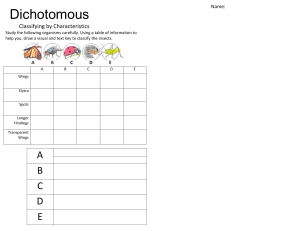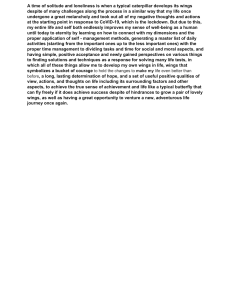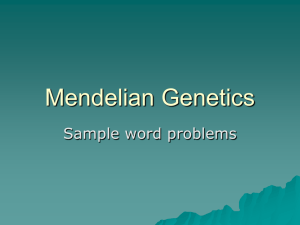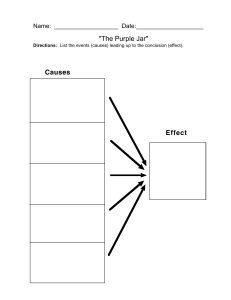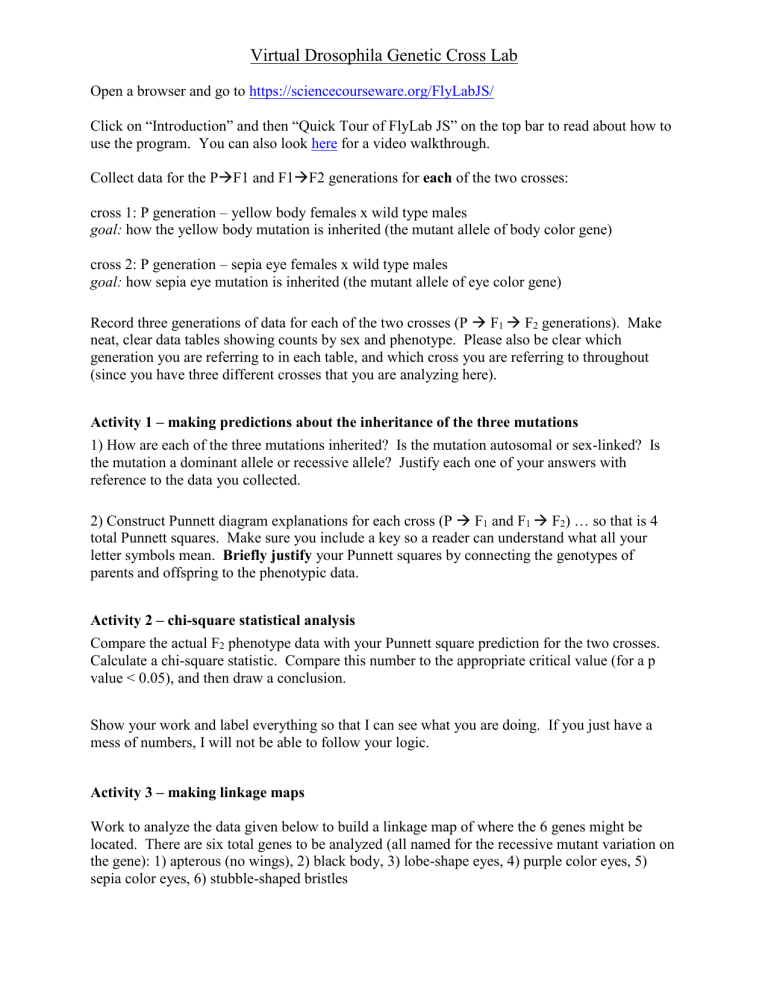
Virtual Drosophila Genetic Cross Lab Open a browser and go to https://sciencecourseware.org/FlyLabJS/ Click on “Introduction” and then “Quick Tour of FlyLab JS” on the top bar to read about how to use the program. You can also look here for a video walkthrough. Collect data for the PF1 and F1F2 generations for each of the two crosses: cross 1: P generation – yellow body females x wild type males goal: how the yellow body mutation is inherited (the mutant allele of body color gene) cross 2: P generation – sepia eye females x wild type males goal: how sepia eye mutation is inherited (the mutant allele of eye color gene) Record three generations of data for each of the two crosses (P F1 F2 generations). Make neat, clear data tables showing counts by sex and phenotype. Please also be clear which generation you are referring to in each table, and which cross you are referring to throughout (since you have three different crosses that you are analyzing here). Activity 1 – making predictions about the inheritance of the three mutations 1) How are each of the three mutations inherited? Is the mutation autosomal or sex-linked? Is the mutation a dominant allele or recessive allele? Justify each one of your answers with reference to the data you collected. 2) Construct Punnett diagram explanations for each cross (P F1 and F1 F2) … so that is 4 total Punnett squares. Make sure you include a key so a reader can understand what all your letter symbols mean. Briefly justify your Punnett squares by connecting the genotypes of parents and offspring to the phenotypic data. Activity 2 – chi-square statistical analysis Compare the actual F2 phenotype data with your Punnett square prediction for the two crosses. Calculate a chi-square statistic. Compare this number to the appropriate critical value (for a p value < 0.05), and then draw a conclusion. Show your work and label everything so that I can see what you are doing. If you just have a mess of numbers, I will not be able to follow your logic. Activity 3 – making linkage maps Work to analyze the data given below to build a linkage map of where the 6 genes might be located. There are six total genes to be analyzed (all named for the recessive mutant variation on the gene): 1) apterous (no wings), 2) black body, 3) lobe-shape eyes, 4) purple color eyes, 5) sepia color eyes, 6) stubble-shaped bristles The data below show all the possible pairings of these genes to follow Morgan’s experiment where he crossed a doubly heterozygous fly for the two genes (inheriting both dominant alleles from one parent, both recessive alleles from the other parent) with a doubly homozygous recessive fly. Hint: There are two different chromosome pairs that these genes might be on. Some of the data below reflect two genes that are NOT linked at all (so they follow Mendel’s prediction for how inheritance should work). Calculate the recombination frequencies for each pairing, and then build a map showing the locations of these genes. The numbers in parentheses, for example (2) just number the genes for you to make things easier down the line. black body (2) & purple eye color (4) dominant: brown body, red eyes recessive: black body, purple eyes apterous wings (1) & lobe eye shape (3) dominant: normal wings, circular eyes recessive: apterous wings, lobe eyes offspring: brown body, purple eyes black body, purple eyes brown body, red eyes black body, red eyes offspring: normal wings, circular eyes apterous wings, circular eyes normal wings, lobe eyes apterous wings, lobe eyes 16 230 234 14 330 65 69 338 apterous wings (1) & purple eye (4) dominant: normal wings, red eyes recessive: apterous wings, purple eyes sepia eye color (5) & lobe eye shape (3) dominant: red eyes, circular eyes recessive: sepia eyes, lobe eyes offspring: normal wings, red eyes normal wings, purple eyes apterous wings, red eyes apterous wings, purple eyes offspring: sepia eyes, circular eyes red eyes, circular eyes sepia eyes, lobe eyes red eyes, lobe eyes 496 3 4 494 apterous wings (1) & sepia eye color (5) dominant: normal wings, red eyes recessive: apterous wings, sepia eyes offspring: apterous wings, red eyes normal wings, red eyes normal wings, sepia eyes apterous wings, sepia eyes 199 202 205 206 112 110 114 108 black body (2) & apterous wings (1) dominant: brown body, normal wings recessive: black body, apterous wings stubble bristles (6) & purple eye (4) dominant: normal bristles, red eyes recessive: stubble bristles, purple eyes offspring: brown body, normal wings brown body, apterous wings black body, apterous wings black body, normal wings offspring: normal bristles, purple eyes stubble bristles, red eyes stubble bristles, purple eyes normal bristles, red eyes 320 26 336 20 48 52 51 55 sepia eye color (5) & black body (2) dominant: red eyes, brown body recessive: sepia eyes, black body black body (2) & lobe eye shape (3) dominant: brown body, circular eyes recessive: black body, lobe eyes offspring: red eyes, black body sepia eyes, black body sepia eyes, brown body red eyes, brown body offspring: brown body, lobe eyes brown body, circular eyes black body, circular eyes black body, lobe eyes 161 166 162 160 48 140 44 146 stubble bristles (6) & black body (2) dominant: normal bristles, brown body recessive: stubble bristles, black body stubble bristles (6) & sepia eye (5) dominant: normal bristles, red eyes recessive: stubble bristles, sepia eyes offspring: stubble bristles, black body normal bristles, brown body normal bristles, black body stubble bristles, brown body offspring: normal bristles, red eyes stubble bristles, sepia eyes stubble bristles, red eyes normal bristles, sepia eyes 188 194 192 196 144 146 68 64 stubble bristles (6) & lobe eye shape (3) dominant: normal bristles, circular eyes recessive: stubble bristles, lobe eyes purple eyes (4) & lobe eye shape (3) dominant: red eyes, circular eyes recessive: purple eyes, lobe eyes offspring: stubble bristles, lobe eyes normal bristles, circular eyes stubble bristles, circular eyes normal bristles, lobe eyes offspring: red eyes, lobe eyes red eyes, circular eyes purple eyes, lobe eyes purple eyes, circular eyes 148 156 157 153 108 497 493 102 purple eyes (4) & sepia eyes (5) dominant: red eyes, red (bright) eyes recessive: purple eyes, sepia (dark) eyes stubble bristles (6) & apterous wings (1) dominant: normal bristles, normal wings recessive: stubble bristles, apterous wings offspring: purple eyes, (bright) eyes purple eyes, (dark) eyes red eyes, (dark) eyes red eyes, red (bright) eyes offspring: normal bristles, normal wings 146 stubble bristles, normal wings 143 stubble bristles, apterous wings 142 normal bristles, apterous wings 147 168 169 164 167 Activity 2 – building a linkage map Use the data presented on the worksheet to calculate gene distances for each gene pair. I have provided a table below to keep track of all your calculations. Gene pair Recombination frequency (%) apterous wings (1) & black body color (2) apterous wings (1) & lobe eye shape (3) apterous wings (1) & purple eye color (4) apterous wings (1) & sepia eye color (5) apterous wings (1) & stubble bristles (6) black body color (2) & lobe eye shape (3) black body color (2) & purple eye color (4) black body color (2) & sepia eye color (5) black body color (2) & stubble bristles (6) lobe eye shape (3) & purple eye color (4) lobe eye shape (3) & sepia eye color (5) lobe eye shape (3) & stubble bristles (6) purple eye color (4) & sepia eye color (5) purple eye color (4) & stubble bristles (6) sepia eye color (5) & stubble bristles (6) Use these recombination frequencies above to build a linkage map below. I did NOT draw chromosome pairs for you – you’ll have to decide how many chromosome pairs these six overall genes might exist on (it is definitely more than one chromosome pair).
